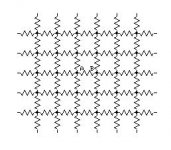Hi All,
Please help me solve this problem:
What is the resistance between points A and B. All resistanses in the mesh are equal to R. The mesh size(NxN) is large.
I remember solving this problem when I was in school, but can't do it now
I also remember it has a very elegant solution.
If you know the answer, please give me a hint
Please help me solve this problem:
What is the resistance between points A and B. All resistanses in the mesh are equal to R. The mesh size(NxN) is large.
I remember solving this problem when I was in school, but can't do it now
I also remember it has a very elegant solution.
If you know the answer, please give me a hint
Attachments
I remember that one. You draw equipotential lines and, since they are equipotential you can connect them without changing anything. Once you have done that the entire thing becomes trivial.
Since the array is symmetrical, you short the same way on both sides.
Actually the one I recall was a cube of resistors where you measure across the diagonal. This one is similar. So fold the whole thing top over to the bottom, hinging on the A-B line. That leaves resistors only below and all are now R/2 except the ones on the hinge line.
Since the array is symmetrical, you short the same way on both sides.
Actually the one I recall was a cube of resistors where you measure across the diagonal. This one is similar. So fold the whole thing top over to the bottom, hinging on the A-B line. That leaves resistors only below and all are now R/2 except the ones on the hinge line.
Last edited:
I remember that one. You draw equipotential lines and, since they are equipotential you can connect them without changing anything. Once you have done that the entire thing becomes trivial.
Since the array is symmetrical, you short the same way on both sides.
Actually the one I recall was a cube of resistors where you measure across the diagonal. This one is similar. So fold the whole thing top over to the bottom, hinging on the A-B line. That leaves resistors only below and all are now R/2 except the ones on the hinge line.
Cube is easy
with this mesh we can fold it across AB line, but this does not help much
I wonder if it helps that you would get the same value no matter which resistor you pick, since the array is infinite. So you can substitute for any resistor the value of the total matrix.
I don't know. This isn't really an electronics problem; it's a logic or math problem.
I don't know. This isn't really an electronics problem; it's a logic or math problem.
Searched the web intensely and what I thought an "elegant" solution seems to be a very spooky one.
Idea is to pump in current in one node (point A) and pump it out from another one (point B). Total current through A->B supposed to be i/4+i/4=i/2, thus Rtot=R/2. I do not think that i/4 current will flow each direction because of symmetry. Symmetry is broken with the presence of the second node. Symmetry case would work if someone wants to measure resistance between arbitrary node and infinitely remote point.
May be I am missing something.
Idea is to pump in current in one node (point A) and pump it out from another one (point B). Total current through A->B supposed to be i/4+i/4=i/2, thus Rtot=R/2. I do not think that i/4 current will flow each direction because of symmetry. Symmetry is broken with the presence of the second node. Symmetry case would work if someone wants to measure resistance between arbitrary node and infinitely remote point.
May be I am missing something.
- Status
- This old topic is closed. If you want to reopen this topic, contact a moderator using the "Report Post" button.
- Home
- General Interest
- Everything Else
- Help - resistance of the mesh
